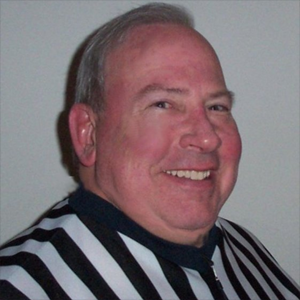
Rndballref
20 Years Experience
Chicago, IL
Male, 60
For twenty years I officiated high school, AAU and park district basketball games, retiring recently. For a few officiating is the focus of their occupation, while for most working as an umpire or basketball referee is an avocation. I started ref'ing to earn beer money during college, but it became a great way to stay connected to the best sports game in the universe. As a spinoff, I wrote a sports-thriller novel loosely based on my referee experiences titled, Advantage Disadvantage
Stop the game. Turn the teams around. All points fouls time outs which occurred stand.
If you obtained legal guarding position and you were dislodged off your spot by an opponent it is a team control foul on your opponent's team.
If two fouls of the same kind occur simultaneously by opposite teams the free throws offset and are not shot. In your example the fouls are different and are administered as they occurred. So clear the lanes, shoot the one and one. Go to the other end and shoot the 2 Ts. Ball out of bounds at half court.
There is no prohibition against bouncing a ball off an opponent. EXCEPT if the ball is thrown maliciously and then it would be an unsportsmanlike technical foul. Referee's judgement as to what severity would cross the line.
Air Traffic Controller
 What was it like in the tower on 9/11?
What was it like in the tower on 9/11?
Zookeeper and Animal Trainer
 Which cuddly-seeming animals are actually dangerous to be around?
Which cuddly-seeming animals are actually dangerous to be around?
Navy Officer (Former)
 Just how educated is the typical US military serviceman?
Just how educated is the typical US military serviceman?
The referee is considered part of the floor, so if the player catches the ball with 2 hands after dribbling and bouncing off a referee, it is double dribble.
If this was not the rule then the following could happen:
if a player was trapped with an official nearby, he could bounce the ball off the official and get a new dribble. This is not the intention, so the referee is part of the floor, and a player DOES NOT get a new dribble after bouncing off the ref.
A two handed bounce is double dribble. So is dribbling a second time after holding the ball. Both are violations.
You need to establish front court possession before you can have a back court violation. Answer is no.
-OR-
 Login with Facebook
Login with Facebook (max 20 characters - letters, numbers, and underscores only. Note that your username is private, and you have the option to choose an alias when asking questions or hosting a Q&A.)
(A valid e-mail address is required. Your e-mail will not be shared with anyone.)
(min 5 characters)
By checking this box, you acknowledge that you have read and agree to Jobstr.com’s Terms and Privacy Policy.
-OR-
 Register with Facebook
Register with Facebook(Don't worry: you'll be able to choose an alias when asking questions or hosting a Q&A.)